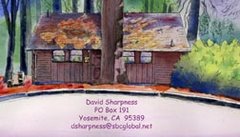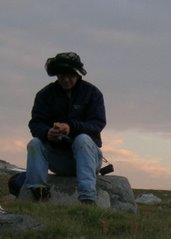
During the glaciers there was a lake here in the Valley...
Web news about cold weather in China...Christian news channel had story too...watched antique road show...now doc. on Grand Central Station...train stations are lonely...that solitude of people coming and going...the Valley has a bit of that...I watch tourists getting on and off the buses...from all over they come and...return...oh...the Christian channel had a good bit on integrated churches..Martin Luther King was quoted as saying that the most segragated day in America was 11 am Sunday..."all equal before the Throne"...even in respect to gender...which is a ponderable!!
anyway...about the Lake...time wise...brb...oh...and note this fellow...Joseph "Snowshoe" Walker...well the Sherwin glacier did most of the work...and the walls are so verticle because of something called 'verticle joints'...the granite breaks off in verticle sheets...and the Valley is flat because it's the bottom of Lake Yosemite...I think the Valley was very swampy until Clark blew a hole in the morrain...and that swamp the last of Lake Yosemite...just how long ago the Valley was actually a lake is a question...fifteen thousand years ago it would have certainly been...Whitney had it in his head to the day he died that Glaciers couldn't have made the Valley...instead he thought earthquakes had dropped the bottom out...it's hard to grasp how slow the Glaciers are...the Sherwin glaciation lasted like three hundred thousand years...and there were lesser ones later....there are things I dont understand...like the rubble atop Mt. Dana..and it's said Hoffman was broken apart by the Glaciers....but these were very near the top and I dont see where that grinding weight came into play...even in the Valley...how everything is sheared off top to bottom...but that "verticle joint" thing seem to be the "plug" to stop any leaking thinking!!...lemegoread some more...brb...oh..a link to a good site: http://www.emporia.edu/earthsci/student/gunther2/yosemite.html
and here's one about the joints...above the Falls, Yosemite Creek tends to follow joints...http://www.yosemite.ca.us/library/geologic_story_of_yosemite/final_evolution.html
Oh...this site explains the undulations...UNDULATING SURFACE below Clouds Rest....it's like it is scalloped...and it can be seen in Half Domes shape too...I wondered about it...this is a very good site...found looking up Mt. Dana's rubble top...which I've yet to find explanation...but it explains the jagged peaks in the High Country...Vogelsang...Ragged Peak...brb...well...in defense of Whitney!...
quote
Yosemite Valley, in spite of its profound glacial modification, is not a good place to see much direct evidence of glaciation. The Tioga glacier only reached as far as Bridalveil Meadow, where its terminal moraine, although well exposed in a roadcut (fig. 74), is relatively inconspicuous, and lateral moraines are absent. Glacial polish and striations are scarce, but they can be seen on a low, flat shelf of rock near the base of the north valley wall opposite the west end of the Yosemite Lodge, and along the base of the cliffs on the north side of the Tenaya Lake Trail, about 500 to 1,000 ft east of Mirror Lake. Glacial polish also occurs in such places as on the slope of the Glacier Point apron, but these localities are accessible only to the experienced climber. This paucity of direct evidence is probably the basis for Josiah Whitney’s stand against the glacial origin of Yosemite Valley, noting as he did the glaciation of Hetch Hetchy Valley, where he described glacial polish at least 800 ft and a glacial moraine 1,200 ft above the valley floor.
unquote
and here Mt. Dana is explained...how neat!!
quote
These upland surfaces did not totally escape the effects of glacial climate. Cycles of freezing and thawing broke the bedrock along fractures and heaved it into a mass of jumbled blocks. Such rubble-covered surfaces are scattered along the Sierran crest, as at Dana Plateau (fig. 78), and include the summit of Mount Whitney 50 mi to the south. The south-facing slope of Mount Hoffmann, our original vantage point in the park, is a somewhat similar upland surface, although slow disintegration and spalling of granite sheets has created an irregular, flaggy surface. This unglaciated surface is abruptly truncated by a glacial cirque cut deeply into the north face of Hoffmann—a striking contrast in erosional processes
unquote
quotes from same site...
and here is a bit important to the Ages of Man...
quote
After the end of the Pleistocene (10,000 years ago), temperatures in many parts of the world rose, reaching a maximum about 5,000 years ago. By that time, probably no glaciers survived in the Sierra Nevada. Temperatures then dropped, first slowly, then more rapidly; and small glaciers began to form in the Sierra once again by about 2,500 years ago.
unquote
I'll have to get the book: The Geologic Story of Yosemite National Park (1987) by N. King Huber
Thing to remember in all this is how slow things happen...
quote
The landscape is slowly but continually being modified. The Sierra Nevada continues to rise—and continues to be eroded. Lakes are being filled with sediment. When erosion outpaces uplift, as it eventually will, the range will be reduced to rolling upland, much as it was tens of millions of years ago. In the meantime, Yosemite remains a delight to the visitor, especially to those who learn to read the story its rocks and landscape have to tell.
Pic is from site...and probably book.
unquote
DavidDavid
Tree in the Door



No comments:
Post a Comment